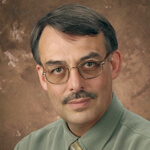
San Antonio (Sept. 17, 2004) – Humans have them. Dogs have them. So does the earthworm. So do sponges, sea anemones and jellyfish. Even plants have something similar.
What do they all have in common? Gap junctions, which are the miniscule channels where cells of the body come in contact with each other and swap information by transferring amino acids, simple sugars and other nutrients, as well as signaling molecules like Ca” (calcium ion) and cyclic AMP.
“Since gap junctions are found in so many systems, we know they are needed for multi-cellular life to function,” said Bruce J. Nicholson, Ph.D., professor and chairman of the department of biochemistry at The University of Texas Health Science Center at San Antonio.
Dr. Nicholson’s research involves examination of the detailed molecular structure of gap junction pores and how they are regulated. His goal is to alter or dictate the properties of the junctions to modify or enhance their function.
Such work promises to improve human health. For example, normal gap junctions seem to suppress tumor growth, but most cancer cells have debilitated gap junctions. Re-establishing gap junction communication between cancer cells may go a long way to slowing or stopping cancer growth.
Several other diseases also are linked to defects in gap junction genes, including Charcot-Marie-Tooth disease, which results in paralysis in young adult males; cataracts; abnormally thick skin; and deafness. “The most common cause of inherited human deafness is a defect in one gap junction gene,” Dr. Nicholson said. “My laboratory was the one that initially cloned this gene, called connexin 26, at the State University of New York at Buffalo, before it was known to be involved in deafness.”
It is estimated that as much as 20 percent of the population may carry defects in the connexin 26 gene. “This connexin gene is the second-most-mutated gene in the human population, right after the gene causing cystic fibrosis,” Dr. Nicholson noted. “Connexins are the proteins that form gap junctions, and there are 20 different members of the connexin family. Why so many? They work differently and let different things through the channel. They are guardians of information transfer, like selective firewalls between cells. If we can change parts of the structure of the connexins, presumably we can make channels that have different properties and hence mediate different functions.”
Dr. Nicholson became chairman of biochemistry at the Health Science Center in March 2004 after 18 years at SUNY-Buffalo, where he was an award-winning researcher and teacher.
A native of Australia, he earned his bachelor of science (B.Sc.) degree from the University of Queensland in 1975. He received his Ph.D. in 1983 from the California Institute of Technology and also completed three years of postdoctoral work at the same institution.
Dr. Nicholson’s mentors have included biochemists Drs. John Paul Revel and Norman Davidson at Cal Tech. Dr. Davidson made several key discoveries about the biophysics of DNA that made much of the modern genetic engineering revolution possible, while Dr. Revel was a founder of the gap junction field.
“The department at UTHSCSA is a very strong biochemistry department,” Dr. Nicholson said of his new appointment. “Our faculty interact well, enjoy research and teaching, and have energy, zeal and pride to maintain research activity and serve as models for new researchers. We also have the resources to further enhance the department over an extended period of time.”
The department’s research strengths include cellular regulation and structure determination using X-ray crystallography, nuclear magnetic resonance, mass spectroscopy, and analysis of molecular interactions using analytical ultracentrifugation and surface plasmon resonance. “I don’t think there’s a department anywhere in the country that has better facilities across the board,” Dr. Nicholson said. “Young candidates from the best places in the country salivate over the equipment when they come to visit. We want to build on the strong foundation that exists, while maintaining the interactive culture that we have.”

